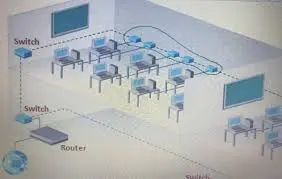In the world of business networking, the choice between managed and unmanaged switches is akin to deciding whether to hire a professional contractor or tackle a home renovation yourself. One offers simplicity and affordability, while the other delivers control and scalability. But how do you know which path is right for your organization? This article breaks down the key differences between managed and unmanaged switches, their pros and cons, and actionable advice to help you build a network that fuels growth—not headaches.

(A split-screen illustration showing a cluttered desk with unmanaged switches versus a streamlined rack of managed switches in a server room. Caption: “The right switch choice can mean the difference between chaos and clarity.”)
What’s the Big Deal About Switches Anyway?
Switches are the unsung heroes of any network, directing data traffic like air traffic controllers. But not all switches are created equal. Unmanaged switches—often called “plug-and-play” devices—are popular for small offices or home networks. They require zero configuration, making them ideal for connecting a handful of devices. Managed switches, on the other hand, are the Swiss Army knives of networking, offering advanced features like VLANs, QoS, and security protocols.
For example, a coffee shop with a few POS systems and guest Wi-Fi can thrive on an unmanaged switch’s simplicity. Meanwhile, a law firm managing sensitive client data across multiple departments would need a managed switch to prioritize traffic and enforce strict security.
Cost vs. Control: The Classic Dilemma
Unmanaged switches win the affordability game. Prices start as low as $20 for basic models, making them irresistible for startups or small teams. But their “set it and forget it” appeal comes with hidden costs. Limited bandwidth management can lead to network congestion, while absent security features expose businesses to cyberattacks.
Managed switches command higher prices—often 5–10 times more—but justify the investment through flexibility. Features like Port Mirroring (for monitoring traffic) and Link Aggregation (combining bandwidth) streamline operations. For instance, a marketing agency using a managed switch can allocate dedicated bandwidth to video editors, ensuring smooth rendering without lag.
Scalability: Planning for Growth
Unmanaged switches are like rented apartments—convenient for now but lacking room to expand. Adding new devices often means buying another switch, leading to messy cabling and fragmented networks. Managed switches, however, act as commercial real estate—scalable and adaptable. With features like VLANs (Virtual LANs), IT teams can segment a single physical network into multiple logical ones. A healthcare provider, for example, can isolate patient data traffic from guest Wi-Fi, improving both performance and compliance.
Security: Fort Knox vs. Open Doors
Cybersecurity is non-negotiable, yet unmanaged switches leave businesses vulnerable. Their lack of encryption and access controls makes them easy targets for attacks like ARP spoofing or man-in-the-middle breaches. Managed switches act as digital bouncers, enforcing security through:
- MAC Address Filtering: Block unauthorized devices.
- 802.1X Authentication: Require user credentials for access.
- Firewall Integration: Some models include built-in firewall capabilities.
A case in point: A retail chain using unmanaged switches suffered a ransomware attack after hackers exploited weak port security. Post-upgrade to managed switches with ACLs (Access Control Lists), breaches dropped by 90%.
Performance Tweaks: Beyond Plug-and-Play
Unmanaged switches are fast—until they’re not. Without traffic prioritization, critical applications like VoIP or video conferencing can drown in a sea of data. Managed switches solve this with QoS (Quality of Service), ensuring high-priority traffic gets bandwidth first. For remote workers, this means crystal-clear Zoom calls even during peak usage.
Managed switches also support STP (Spanning Tree Protocol) to prevent network loops, a common issue in complex setups. A logistics company handling real-time shipment tracking eliminated network outages by implementing STP on their managed switches.
Real-World Scenarios: When to Choose What
Let’s ground this in practicality:
- Small Business with 10–20 Employees: An unmanaged switch suffices for basic needs like file sharing and internet access. Example: A boutique salon managing reservations and social media.
- Mid-Sized Enterprise with Branch Offices: Managed switches enable centralized control and secure remote access. Example: A consulting firm with teams in three cities.
- Data-Heavy Environments: Hybrid models combining both types optimize costs and performance. Example: A hybrid cloud setup requiring both IoT devices (unmanaged) and mission-critical apps (managed).
The Verdict: Match Tools to Your Mission
Choosing between managed and unmanaged switches isn’t about one being better—it’s about aligning the tool with the task. Unmanaged switches are budget-friendly for simple networks, while managed switches empower businesses to scale securely.
Ask yourself three questions:
- How many devices need connectivity? If it’s under 20, unmanaged might work.
- Does my team have networking expertise? Managed switches require skilled IT support.
- What’s the cost of downtime? For mission-critical operations, managed switches pay for themselves.
In networking, there’s no universal “best” switch—it’s about strategic alignment. By understanding the strengths of managed and unmanaged switches, you can build a network that’s not only efficient today but adaptable to tomorrow’s challenges. Remember, the right choice isn’t just about avoiding lag; it’s about empowering your business to thrive.

Leave a comment